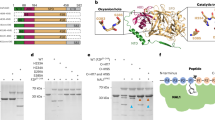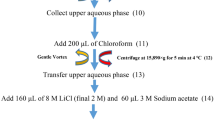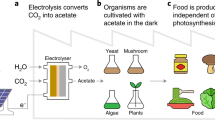Abstract
THERE is little agreement concerning either the pathway or the final products of the enzymic oxidation of heteroauxin1. The stoichiometry of the oxidative decarboxylation seems to be reasonably well established1, one mole of oxygen being taken up and one of carbon dioxide evolved for every mole of indole-3-acetic acid (IAA) reacting. Galston2 reported that no indole-3-aldehyde was formed when IAA was destroyed by a pea brei (see, however, Racusen3); two principal products were formed with RF very close to that of o-aminoacetophenone (I) and o-formamidoacetophenone (II) and giving similar colour reactions. On the basis of a ferric chloride test, Galston concluded that these compounds were hydroxylated derivatives of (I) and (II). Indole-3-aldehyde has an RF intermediate between those of (I) and (II) and does give a brownish-pink colour with ferric chloride; the colour reported by Galston is undoubtedly due to the spot for the indolealdehyde overlapping on to the other two spots. It also seems most unlikely that the RF of phenolic derivatives of both (I) and (II) should be the same as those of (I) and (II). Finally, should such phenols be formed, the uptake of oxygen should be at least 1.5 times that actually reported. Using an oxidizing enzyme from Omphalia flavida, Stowe et al.4 rejected the possibility that (I), (II) or indolealdehyde was formed in any amount and suggested that the product (not isolated) might be 3-methyldioxindole. From their chemical evidence it seems rather unlikely that their product was 3-methyldioxindole. Most of their observations can be explained on the basis of our present results. With Lupinus seedlings Stutz5 obtained a number of products (one of them being indolealdehyde) chromatographically similar to those obtained by Galston2. Using substituted 3-indoleacetic acids Stutz concluded that the ring system (probably C2) and not the side chain was the primary site of dehydrogenation.
This is a preview of subscription content, access via your institution
Access options
Subscribe to this journal
Receive 51 print issues and online access
$199.00 per year
only $3.90 per issue
Buy this article
- Purchase on Springer Link
- Instant access to full article PDF
Prices may be subject to local taxes which are calculated during checkout
Similar content being viewed by others
References
Ray, P. M., Ann. Rev. Plant Physiol., 9, 81 (1958).
Galston, A. W., in The Chemistry and Mode of Action of Plant Growth Substances, edit. by Wain, R. L., and Wightman, F., 219 (Butterworths, 1956).
Racusen, D., Arch. Biochem. Biophys., 58, 508 (1955).
Stowe, B. B., Ray, P. M., and Thiman, K. V., Eighth Cong. Intern. Botan., Paris, Rapps. et communs., Suppl. Vol., 135 (1954). Ray, P. M., and Thimann, K. V., Arch. Biochem. Biophys., 64, 175 (1956).
Stutz, R. E., Plant Physiol., 33, 207 (1958).
MacLachlan, G. A., and Waygood, E. R., Physiol. Plantarum, 9, 321 (1956); Canad. J. Biochem. Physiol., 34, 1233 (1956).
Waygood, E. R., Oaks, A., and MacLachlan, G. A., Canad. J. Bot., 34, 54, 905 (1956).
Hewitt, E. J., Nature, 180, 1020 (1957).
Horning, E. C., Sweeley, C. C., Dalgliesh, E. C., and Kelly, W., Biochim. Biophys. Acta, 32, 566 (1959).
Elderfield, R. C., Heterocyclic Compounds, 3, 69 (John Wiley and Sons, New York, 1952).
Author information
Authors and Affiliations
Rights and permissions
About this article
Cite this article
ABRAMOVITCH, R., AHMED, K. Oxidative Decarboxylation of Indole-3-acetic Acid by Mangani-Versene and by Wheat Leaf Enzyme. Nature 192, 259–260 (1961). https://doi.org/10.1038/192259a0
Issue Date:
DOI: https://doi.org/10.1038/192259a0
This article is cited by
-
Auxintransport und Phototropismus
Planta (1968)
-
Indoleacetic acid oxidase
The Botanical Review (1964)
Comments
By submitting a comment you agree to abide by our Terms and Community Guidelines. If you find something abusive or that does not comply with our terms or guidelines please flag it as inappropriate.



